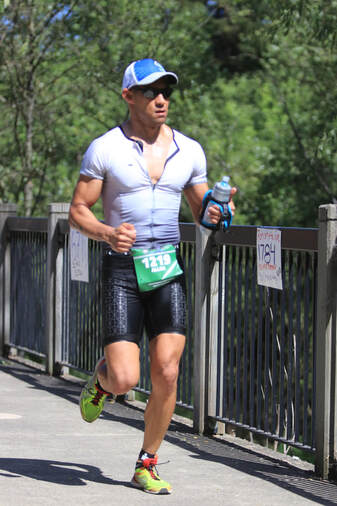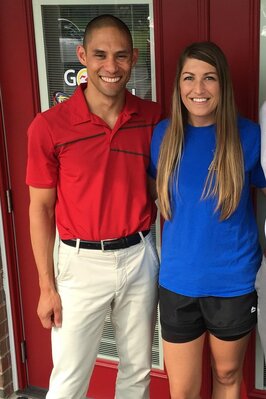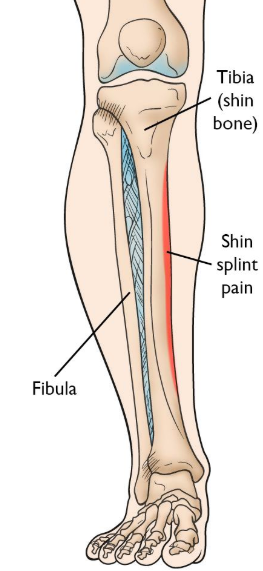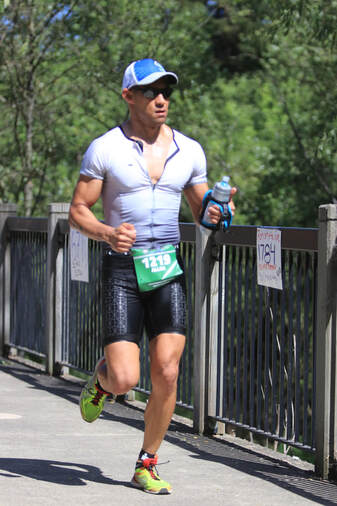|
I know the feeling. Been running along and then BAM…who just whacked the side of my knee with a baseball bat?? Oh, wait…there’s no one around…
Knee pain is one of the classic issues that can befuddle runners. The problem is that not all knee pain is created equal. Saying “knee pain” can mean any number of things, and quite often the problem is far away from the knee. Sure, we need to calm down the pain if we want to start moving normally, but long-term progress requires us to search a little deeper. The purpose of this guide is to help you as an athlete navigate what can seem like an unsolvable puzzle, especially when you’ve been trying to find a solution for weeks, months or even years.
0 Comments
What is plantar fasciitis (“PF”)? If you’ve had it, you certainly know it doesn’t feel very good! “Plantar fasciitis” is very broad term commonly applied to any pain on the bottom of the foot. Sometimes the condition is not plantar fasciitis at all, but instead a strained foot muscle or “fat pad syndrome” (more on that diagnosis later). Ultimately, for the patient, the specific diagnosis doesn’t matter too much because the treatment approach will be very similar (assuming we stay in the realm of orthopedics and aren’t dealing with a condition unrelated to muscles, tendons/ligaments or bones).
I call plantar fasciitis an “equal opportunity offender” because you’ll find it in elite athletes who dedicate insane training volumes to their sport but also in sedentary people who walk no further than the bathroom, and of course every type of person in between. In other words, you can get it from doing too much or from not doing enough. Practically speaking, you’ll find plantar fasciitis manifested in several different ways. First, the classic presentation of plantar fasciitis is isolated tenderness toward the front/middle of the heel, at a landmark called the medial calcaneal tubercle. Although the pain might extend along the entire foot, for this version of plantar fasciitis, the hallmark is localized pain at that specific point on the heel. Additionally, patients with this presentation will often feel pain at its worst in the first step of the morning. Another similar common presentation is pain further back toward the heel but still on the bottom of the foot over a broader area. This is sometimes called fat pad syndrome if the primary source of pain is the fat pad on the heel rather than the plantar fascia. But again, the causes behind the condition are very similar so the treatment approach should look similar as well. Plantar fasciitis may also refer to pain in the arch of the foot. Again, this may be a result of true plantar fascia inflammation or it could be referred pain patterns from elsewhere in the body. It could also be a strained muscle, as there are many muscles on the bottom of the foot that perform a variety of functions. 1. CHANGE YOUR CADENCE Changing to a faster cadence is one way to decrease stress on the foot. Cadence is a more complicated issue than footstrikes-per-minute, but do know that changing to a faster cadence is often accompanied by OTHER changes known to decrease loading, most notably a forward lean and shift to a more forefoot strike. My personal preference is that if you are going to change mechanics, let the mechanical changes emerge as a BYPRODUCT of focusing on cadence rather than flooding your mind with technical cues that may be difficult to implement in real time. 2. FIND SOFT RUNNING SURFACES This isn’t possible 100pct of the time for everyone, but the sacrifice can be worth it. When I’ve been on the cusp of injury, I’ve done endless loops around a grass soccer field to get the mileage in while minimizing the risk of further injury. There’s precedent for this too at the highest levels of running, as USA Olympians Galen Rupp and Dathan Ritzenheim (both historically injury prone) have been known to do up to 20 miles around a 600m grass loop! As a caveat, there isn’t as much evidence to support this strategy as we might think. That said, anecdotally countless runners report fresh and rejuvenated legs after dedicating the time and effort to run more on grass. Article: The Benefits of Running on Grass (Triathlete Magazine) 3. TRAIN SMART! Probably the most important strategy of all. Smart training provides the right amount of stimulus for the body to adapt and become stronger; excess training provides a stimulus too great for the body’s adaptive capabilities. This doesn’t necessarily mean physical breakdown though. Pain could be a warning signal, especially notable given the high density of nerve tissue in the feet. With excess loading, the foot can become more sensitive to pain, meaning it takes less of a stimulus to provoke a higher level of pain than before. All this information returns us to the concept that the first line of defense against plantar fasciitis (or any injury for that matter) is to pick the right training loads. 4. SELF-MASSAGE YOUR FOOT For self-massage, the simplest would be direct pressure. Just put your finger on a tender spot and hold it there. You can also massage along the foot, finding those “rough” spots or knotted areas and working them out. Though people often report mixed results from self-massage in other areas of the body, the foot tends to respond quite well, perhaps because the foot is so dense with nerve tissue. Another form of self-massage is instrument assisted soft tissue mobilization. This is just a fancy term for using different objects to perform self-massage! There are plenty of commercial products on the market, some designed specifically for the feet. Everyone has their own preferences, from the hardness of a golf ball to the softness of the spikey ball. Of all the implements available the spikey ball seems to be the most well received. Every is likely aware of the conventional advice to treat shin splints: R.I.C.E., stretching, a switch to softer running surfaces, training plan modifications, maybe a new pair of shoes or a change in running technique. While each of these techniques have merit as treatment approaches, sometimes you need to think a little outside stay on your feet with minimal disruption in training.
Now, before we treat "shin splints" it is important to confirm that shin splits are really what we're dealing with. For purposes of this article, we'll associate the term shin splints the diagnosis of medial tibial stress syndrome ("MTSS"). In the popular lexicon, shin splints are frequently associated with a myriad of diagnoses including anterior compartment syndrome, anterior tibial tendonitis and stress fractures or stress reactions, among others. The shin splints we'll discuss here involve pain along the inside of the shin as shown below. Last year I took on my first full Ironman at Ironman Santa Rosa. Circumstances were not ideal, given that I was fully immersed in an accelerated Doctor of Physical Therapy program. However, with some friends putting together a group trip to the race, I couldn’t pass up a chance to tackle the distance with a good crew. A “proper” base build was totally out of the question. Rather than pass on the race, I took the attitude of “Do my best given whatever resources I have available.” If time is a limitation, then we make the most of the time we have (note: this doesn’t mean hammer every session…more on that below…) Long training history and high training age help a lot. I did my first triathlon in 2001. Minimalism probably isn’t for anyone attempting a couch-to-Ironman program. But it can be done with a large fitness, base even if it comes from a single sport. Based more than 15 years of base, finishing this “long training day” was not an issue. It was simply how much can I sneak into the “zone of performance” without a high risk of complete blow up Although I said not every day should be a hammer session, your training will definitely shift more toward the “quality” end of the quality vs quantity continuum. Let’s start with swimming (in full disclosure my swim was a disaster, but I largely blame that on a poor wetsuit fit rather than fitness). Swim people may be familiar with USRPT, or Ultra Short Race Pace Training. If you want the details of this approach, there are plenty of resources HERE Sample USRPT workout Repeat 50s on an interval giving approximately 20 seconds rest. Select a target time for each rep (say 40 seconds for example). Keep swimming until you swim a rep slower than 40 seconds. Once that happens, you sit out the next rep. Continue this pattern until you miss three reps. Here’s the bottom line for swimming: quality rules. Don’t get sucked into the long slow distance approach that can be effective for bike and running. You don’t have to follow USRPT but you shouldn’t forget that swimming is a strength and technique sport. That said, and this may sound contradictory, If there’s one thing I wish I would have done differently it is implement one weekly long continuous swim. You might be wondering, why bother swimming if it is by far the shortest portion of the event? In my opinion, swimming has the greatest fitness carryover to other events and is also the one least likely to cause injury. Another key component of swim training was pulling with paddles/buoy/band. Technically this is not pure USRPT (which forbids the use of “toys”) but because paddles/buoy/band is the most effective way to simulate wetsuit swimming, it deserves a place. Also, if you follow the philosophy of Brett Sutton, which I do to an extent, you’ll also realize the paddles/buoy/band combo is simply a good way to get good at swimming. Run training. Two to three key runs per week. All other runs 30-60 minutes of easy running. The key runs included:
a) Short fartlek such as 15 x minute hard/minute easy b) Longer fartlek such as 6 x 3 minutes hard/90 seconds easy c) Easy to moderate paced long run of 10-12 miles (longest single run of the prep was 12 miles) Ideally, run your long runs on hilly, soft terrain. This will protect your legs and also build run specific strength Why fartlek? There were times during travel during which I was time crunched. Sometimes the whole workout was 8-10 x 50-100m running sprints at 95% effort. If you can’t get in volume, be sure to get in some quality. But again, quality does not mean thrashing yourself with puke-fest HIIT workouts day after day… Speaking of strength. I’ve often said that kettlebell swings have been a secret to maintaining bike fitness without actually biking lol.. My strength program was relatively informal, but was a mix of low rep kettlebell lifts (mainly the bent press) along with bodyweight (one arm one leg push up and pull ups). In my opinion, carving out some time for strength can be beneficial for health and injury prevention. The key is to find ways to limit the footprint that strength training has on the overall week. Unless you live very near a gym, driving any significant distance for strength training during a minimalist Ironman approach is simply a waste of time because there is so much you can accomplish away from the gym I wouldn’t use strength as a way to replace workouts, other than occasionally on the bike, but that was many weeks before the race. Using the grease-the-groove approach is effective if you have the latitude to make it work. That’s probably the most time and resource efficient way to accomplish what you need without borrowing time from swim/bike/run training. We often use “minimal effective dose” as a worn out cliché, but it really is the best philosophy in this context for strength Biking was mostly Spinervals videos under one hour. Occasionally for shorter rides I’d pull something on youtube that seemed to fit the session objective (recovery, intensity, etc). Only once did I go over two hours indoors. One of the keys to indoor riding was also the opportunity to spend time in the aerobars. Watch any Ironman and halfway through the bike, hundreds of athletes are seated up, out of the aerobars (quite the irony whenever you see an athlete on a $8,000 bike riding as unaerodynamically as possible). Despite low mileage, spending such a high percentage of my bike time in the aerobars was an example of “free speed.” Longest ride outdoors was 75 miles, but done at a moderately intense effort on a bike path with minimal stops. You hear a lot about the magic century ride for Ironman, but how often are these done with traffic stops and even coffee stops, not to mention when in a group where you can’t safely hang out in the aerobars for long stretches. Nutrition...This is one area where experience is especially valuable. With limited opportunities to truly rehearse race day fueling, you’ll have to rely upon what worked in previous races. This might scare some people but I also believe that many nutrition problems are really pacing problems. In other words, when people say “I didn’t get my nutrition right,” what really happened is they went out too hard on the bike and their stomach couldn’t adequately fuel a pace that was unsustainable from the outset This part is hard to quantify, but I was especially attentive to fatigue from travel or other life events. Since the volume was low to begin with, there was no need to force anything. I’ve trained myself out of plenty of races over the years and I wasn’t going to make that same mistake for my first Ironman Overall, it’s really not that complicated. Key points are mindset and expectation management. And then sticking to the race day plan. Having limited training volume simply reduces your margin for error but does not preclude a successful outcome. There’s an old saying that being 10 percent undertrained (and healthy) is better than being 5 percent overtrained. A minimalist Ironman prep is a perfect way to put this concept into practice. You may surprise yourself when you give yourself the chance to arrive at the start line fresh and chomping at the bit to go race. Allan Phillips, PT, DPT Oro Valley Physical Therapist, USA Triathlon Certified Coach  “You’ll hurt your knees if you run.” This old yarn has been spun for decades…but is it true?? Conventional thinking has long believed that “running is bad for your knees,” largely based on anecdotal observation and blanket assumptions. Yes, runners are injured a lot (much of it self inflicted through poor training choices, not the inherent act of running). But does high prevalence of overall injury equate to chronic “bad knees”? A meta-analysis (aka, really big study looking at a bunch of other papers) from 2017 by Alentorn-Geli, et al, examined several studies encompassing over 100,000 runners of all levels and control groups of non-runners to see if any association existed between running and arthritis. Bottom line up front: Amateur runners (non-professionals) experience LOWER rates of hip and knee OA compared to runners who compete for money or people who don’t run at all. Among the amateur runners, the OA rate was 3.5% whereas more than 10% of the non-runners experienced OA, as did more than 13% of the professionals. (Also of note was that running for less than 15 years was associated with lower OA rates). Based on these findings from a large set of data, running actually could be good GOOD for your joints, when done below the professional level. This makes physiological sense when viewed through the lens of Wolff’s Law, which states that bone will remodel in response to the forces or demands placed upon it. If you expose bone to repeated stressors of running it will grow stronger along the lines of forces applied. But we also know that with any stressor applied to the body, any excess force beyond the body’s ability to adapt can lead to undesirable changes, such as injury or chronic strain. A subsequent 2018 study by Ponzio et al (thus not included in the 2017 meta analysis) on marathon runners of all levels found that age, family history and surgical history were predictive of hip or knee OA, but there was also NO significant risk associated with running duration, intensity, mileage, or the number of marathons completed. Additionally United States marathon runners in this sample experienced significantly lower OA rates (8.8%) as compared to the US average (17.9%). Do runners get hip and knee OA? Yes, of course. But so do people who don’t run at all…and those people seem to get MORE OA than amateur runners by a notable margin. Take home point: ALL types of people develop knee problems through the normal course of aging. Some happen to be runners, some don’t run. While intense training levels from the professional level seem to be related with increased OA signs, if we are to infer any causation from evidence, it would be that modest amounts of running could be protective against OA. Regardless, it would seem there’s enough evidence to cast significant doubt on the old suspicion that “running is bad for your knees.”  Let me tell you about our patient Ashley… Ashley came to see me just weeks after starting an exercise program. Having turned 30 the previous August, she felt a sense of urgency in her life. Single and childless, the proverbial biological clock loomed in her consciousness. Professionally, life was great in her teaching job. But she knew she needed to make changes to her lifestyle. Having been a casual smoker for years, the first step was to give up smoking and began exercising. Pizza and donuts also gave way to smoothies and salads. So firm was her commitment to change that she began this transformation in December, before the traditional “New Year’s Resolution” crowd. She found a welcoming home at the local Orange Theory and hired a personal trainer. She started craving the endorphin rush of the HIIT training and seeing the progress in her physique. But one day in January she felt an unwelcome twinge beneath her knee. A trip to the doctor confirmed it was a stress fracture, and she was “sentenced” to at least six weeks of limited weight bearing on her injured leg and an even longer time in a knee brace. Over the next several weeks, she was diligently committed to the plan, as an active participant in manual therapy to control pain and swelling, while incorporating strength and mobility training to recover the function she had lost in the weeks of wearing a brace and guarding against pain. But more important than recovering her function was recovering her confidence. Before each session on the treadmill, she required gentle reassurance of what she had already accomplished with ease in prior sessions. With each successful progression, her confidence and trust in her leg grew more robust. Thanks to quick healing, she was soon ready to return to Orange Theory. We had several talks about communicating with the coaches to find alternatives for jumping and running, which eased many of her concerns. Then before her first class back, I received a text from her sitting in the parking lot..”I’m scared :(“ And who in her situation wouldn’t be? If anything, I was proud of her for recognizing her fear and pausing before entering a situation where she didn’t feel comfortable. Fortunately, she only needed a couple reminders of the physical and mental strategies that had worked for her in the clinic. Within minutes, she made a successful return to class and was back on course to living the new life she had envisioned for herself. What can we learn from Ashley? Rehab is not just the physical. Strengthening the body is important, but callousing the mind is vital. Ashley regained her healthy lifestyle by confronting her fears and gaining strength through the daily victories she experienced both inside and outside of the clinic. If you need help reclaiming the active lifestyle that pain and injury have robbed from you, please reach out to Ventana Physiotherapy for a 30 minute Discovery Visit to discuss how we can best serve you. Dr. Allan Phillips Owner, Ventana Physiotherapy 520-306-8093 allan@ventanapt.physio www.ventanapt.physio |
AuthorAllan Phillips, PT, DPT is owner of Ventana Physiotherapy Archives
December 2023
Categories
All
|
North Location
(Inside GRITfit)
7980 N Oracle Rd.
Tucson, Arizona 85704
Call or Text: (520) 306-8093
allan@ventanapt.physio
(Inside GRITfit)
7980 N Oracle Rd.
Tucson, Arizona 85704
Call or Text: (520) 306-8093
allan@ventanapt.physio
Central Location
(Inside Bodywork @ Onyx)
2951 N. Swan Rd.
Tucson, Arizona 85712
Call or Text: (520) 306-8093
allan@ventanapt.physio
(Inside Bodywork @ Onyx)
2951 N. Swan Rd.
Tucson, Arizona 85712
Call or Text: (520) 306-8093
allan@ventanapt.physio
Terms of Service (here)
Privacy Policy (here)
Medical disclaimer: All information on this website is intended for instruction and informational purposes only. The authors are not responsible for any harm or injury that may result. Significant injury risk is possible if you do not follow due diligence and seek suitable professional advice about your injury. No guarantees of specific results are expressly made or implied on this website.
Privacy Policy (here)
Medical disclaimer: All information on this website is intended for instruction and informational purposes only. The authors are not responsible for any harm or injury that may result. Significant injury risk is possible if you do not follow due diligence and seek suitable professional advice about your injury. No guarantees of specific results are expressly made or implied on this website.
Proudly powered by Weebly



 RSS Feed
RSS Feed